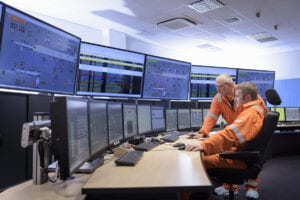In order to maximize your machine efficiency you need to control and monitor your application’s performance continuously (COP= Coefficient of performance). Based on exported data we can plan for service and maintenance to help reduce the machines downtime and more precisely plan for resource management.
Watch your application continuously:
Continuously monitoring helps you maintain a certain level of performance that is optimal (COP) and allows you to quickly adapt if things go out of bounds. For example, power factor correction capacitors can release the foam (KVAR) so you will not have to buy a larger glass (KVA) or pay less for your beer (KW), this is a similar process regulation in industry applications to prevent paying a penalty to the electrical suppliers in case of reactive power absorption from the network.
Glass Capacity = Apparent power(S, KVA)
Foam = Reactive power (Q, KVAR)
Beer = Active Power (P, KW)
Power Factor= Beer (KW) / Glass Capacity (KVA)
Although different kinds of regulators, controllers… are widespread we do need to monitor and control the application not only because of changing parameters and monitoring variables, but also because of downloading and testing the program via the internet.
WEB Visualization functionalities allow this monitoring and control, but without the traditional limitations. There are no additional costs, no need to have specific hardware or wiring (such as: HMI or industrial PC) with the added benefit of a reduction of engineering time and the elimination of unnecessary trips to the site consequently taking care of the environment by having less (CO2 emission) footprint.
Web capabilities today make having complete remote access for machine manufacturers and system integrators possible. Similarly, the facility of connecting machines over the Internet is offered to end users who can monitor their systems both locally and remotely, typically using easy-to-understand graphics interface of any common browser via smart phone, tablet or PC.
Web Server/Customized Page
You can create and manage web pages within the WEB Visualization…effectively a personal website in miniature. WEB functionalities can be used to create a complete local or remote access solution by way of a simple browser.
Note. The PC can always be connected to the WEB Visualization.
Data logged files created by controller can be published on the same WEB page as well as real time data or real time data could be collected in the PC with third party software tools accessing to the controller directly.
Creation of Web Site
As shown in the figure below, you could have your own variable names (NTC temperature sensor), variable access level (read only or read/write), categories (measurement & drive control), header/s (M171= PLC family name in this example), logo (your company logo)…to be user-friendly for the operators; the PLC programming software provides the tools needed for construction of the web site. The objects to display and/or edit on the web pages are defined by the PLC application created with Application (EEPROM parameters, BIOS or status variables).
Embedded Page: If you want to have fast and basic access without any settings or programming… for the simple/ individual machines, physical digital and analogue input/output, systems and configuration of application variables/parameters, you can use a “Template Page” in few minutes, in other words a self-generating page created to a specific template as seen by the table of contents below (typing IP address, username & password in the internet browser).
Bridge
Bridge is the functionality which allows you to connect via Modbus/TCP to the Modbus slave connected to a master PLC via Modbus RS485. If the bridge function is enabled and you connect via Modbus/TCP, the master PLC will forward the message to the addressed slave. In a Connection project, this would involve additional configuration of the various Modbus/RTU Slaves as Generic Modbus RTU nodes. The ‘Node number’ field is used as an index to address each slave on the programming software. To reach the desired ‘node number’ specified in the project, the Bridge function is called with the selected node [0 … 127] and enable status: = TRUE.
Text E-Mails
With WEB Visualization, text e-mails can be sent by way of an SMTP Client.
Any files to be sent can be included as text in the body of the mail.
Master / Slave controller
If there is Master/Slave targets in the Connection project, WEB Visualization is used as a gateway allowing communication between the programming software (PC connected via Modbus/TCP-IP with WEB Visualization) and the slaves in the Modbus/RTU network.
To cut the story short, based on my experience mostly from the End User/OEM pain points, remote control (embedded or customized web pages) access to machines provides more confidence and trust for both parties, not only because of costs reduction but because of less downtime for machine servicing and maintenance due to a much clearer picture of the machine’s performance/efficiency and also for future improvements/developments.



